Aligning Marketing and Sales to Strengthen Your Pipeline
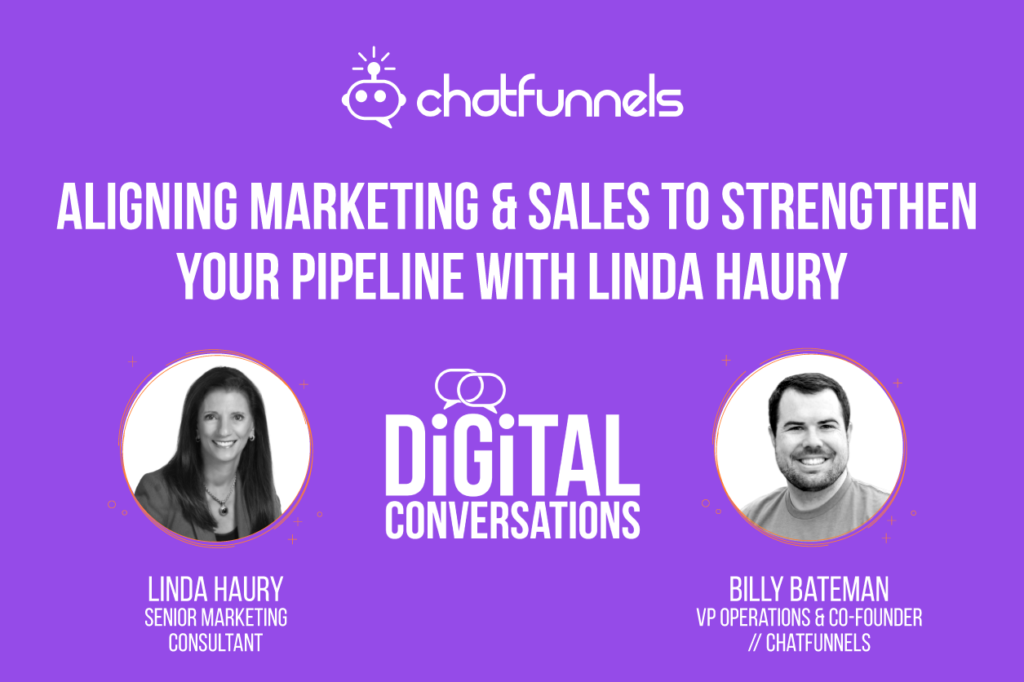
This week on Digital Conversations, Billy chats with Linda Haury about marketing automation, predictive modeling, and the alignment of sales and marketing teams.
Guest: Linda Haury – Linda has more than 20 years of marketing and leadership experience. She has worked for a wide variety of firms, from startups to large, Fortune 500 companies. She has a passion for making data-driven decisions, and is an industry leader in marketing automation. Connect with her on LinkedIn to learn more!
Listening Platforms:
Transcript
Billy: Alright, everyone, welcome to the show today. Today I have the pleasure of being joined by Linda Haury, the lead queen. Linda, how are you today?
Linda: I’m doing great. Thanks for having me on.
Billy: I’m excited to have this conversation with you. It’s gonna be good. So, before I let you introduce yourself, just give everybody a little background. You’ve worked with a lot of different places and you’re currently a consultant in the area of marketing and demand generation specifically. But I’ll let you take it from there and just tell everyone about yourself.
Linda’s Background
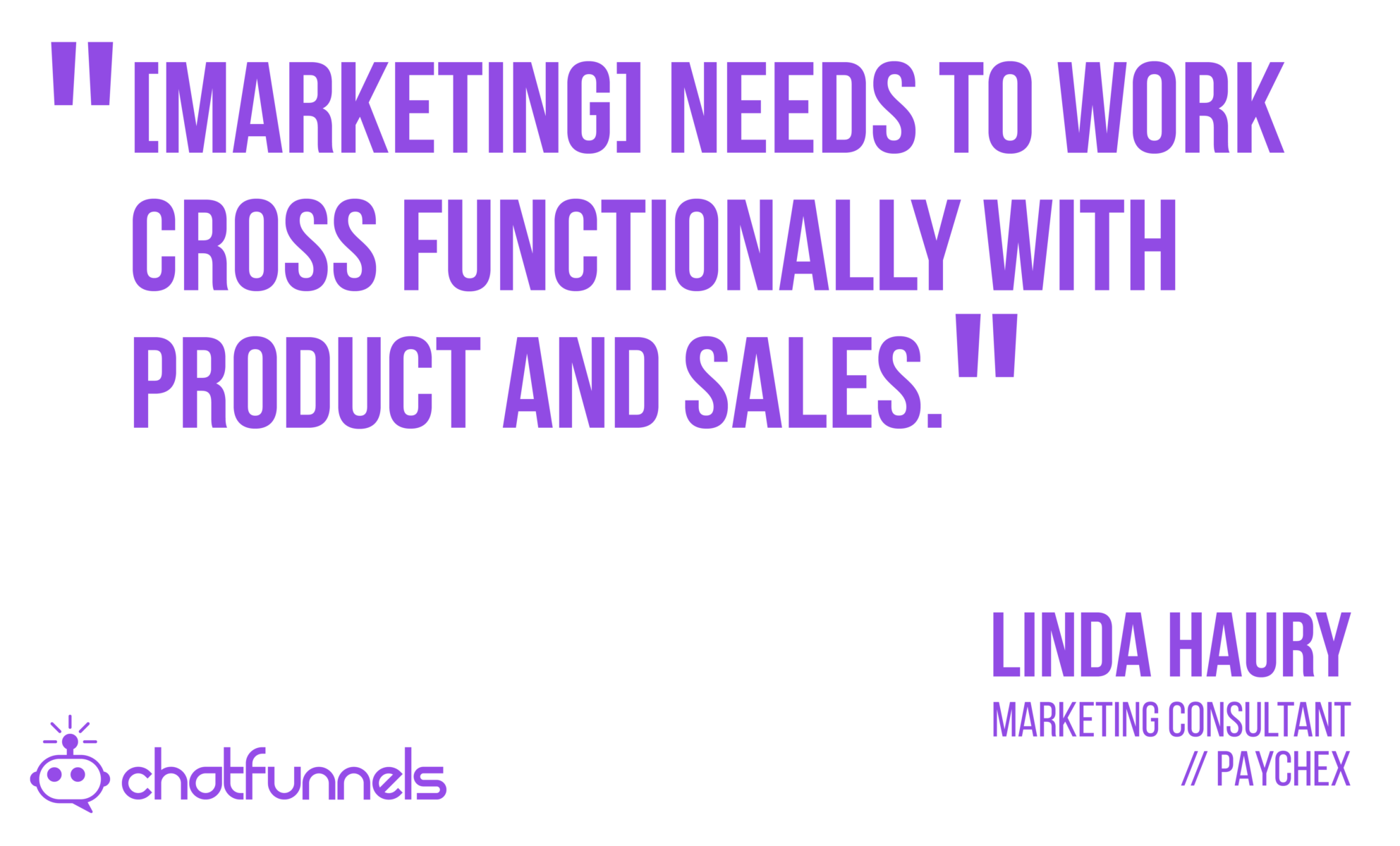
Linda: Okay, well, thank you very much. I’ve actually had 20 plus years in the marketing area, mostly in demand generation. Most of that was around demand generation marketing automation. In my early years, I spent 14 years with a major software company, Citrix. And in the early days, we didn’t go home at night until all the leads were in the system.
There was no marketing automation at the time, things of that sort. That was just sort of the rule. Early on, we really understood the value of sales and marketing alignment, or more recently referred to as sales and marketing integration. And we really found that to be extremely helpful when we started to bring marketing automation and connect CRM system. And we started doing lead nurturing, lead scoring, predictive modeling. So I spent a lot of time at Citrix really developing demand generation, marketing automation, when it was just starting up around the 2005 era, when people were just starting to get used to it. I was there for 14 years, and then I pivoted industries and went into a security, fire and HVAC company originally called Tyco, then merged with Johnson Controls.
And there, we built the demand generation model from the ground up. And believe it or not, that model is still in place today. It was very instrumental in driving opportunity pipeline for the sales organization. And from there today, as you had mentioned, Billy, I’m a consultant, and I’m doing some consulting and marketing demand generation for some top ranked companies, and also helping build high performing marketing teams.
Billy: Awesome. Awesome. And that’s really what we want to want to dig into is how you build these marketing teams and get them ultimately to work together with sales. But before we do this, I’ve got one question that I ask everybody. So I’m not going to let you dodge it. So Linda, if we were to look you up on social, and try to figure out who Linda is on LinkedIn, Facebook, Instagram, Twitter, whatever you have. What’s something that there’s no chance we’re going to know about you by doing that?
Linda: Gosh, that’s an interesting one. Well, I’ve sat on the board, I do a lot of charitable work, because I really believe in giving back. And I stand on the board of a organization called PACE Center for Girls. I’ve sat on that board for almost 20 years. And what we do is we mentor young women, and we help them recognize their potential. Which is paramount, of course, to their success in the future. What we do is really provide girls and young women an opportunity for a better future through education, counseling, training, advocacy.
The fact that I have a desire to help them in the areas mentoring, that has really spilled over into business also. And really helped me in building marketing teams, because I really believe that everyone needs a mentor. So that’s probably something you would not get from my LinkedIn profile.
Billy: Well, that’s great. So super important, the mentoring aspect to that. I got into the, into software through a mentor of mine. And it just takes somebody I think to believe in somebody and give them a little bit of a push and direction. And that goes a long way. So, okay, so let’s get into it.
Aligning Sales and Marketing
One of the things when we first got together and said, hey, maybe we should do a podcast, that you were talking about that I loved is getting that alignment between sales and marketing. Because there’s always a little bit of tension, and tension is not always a bad thing. But you had some really good tactics and strategies for getting sales and marketing aligned and all working towards the same goal. Because we really are like, ultimately, we just want to sell more widgets or services, whatever it is. So if you want to walk us through your methodology, I think that that would be really helpful.
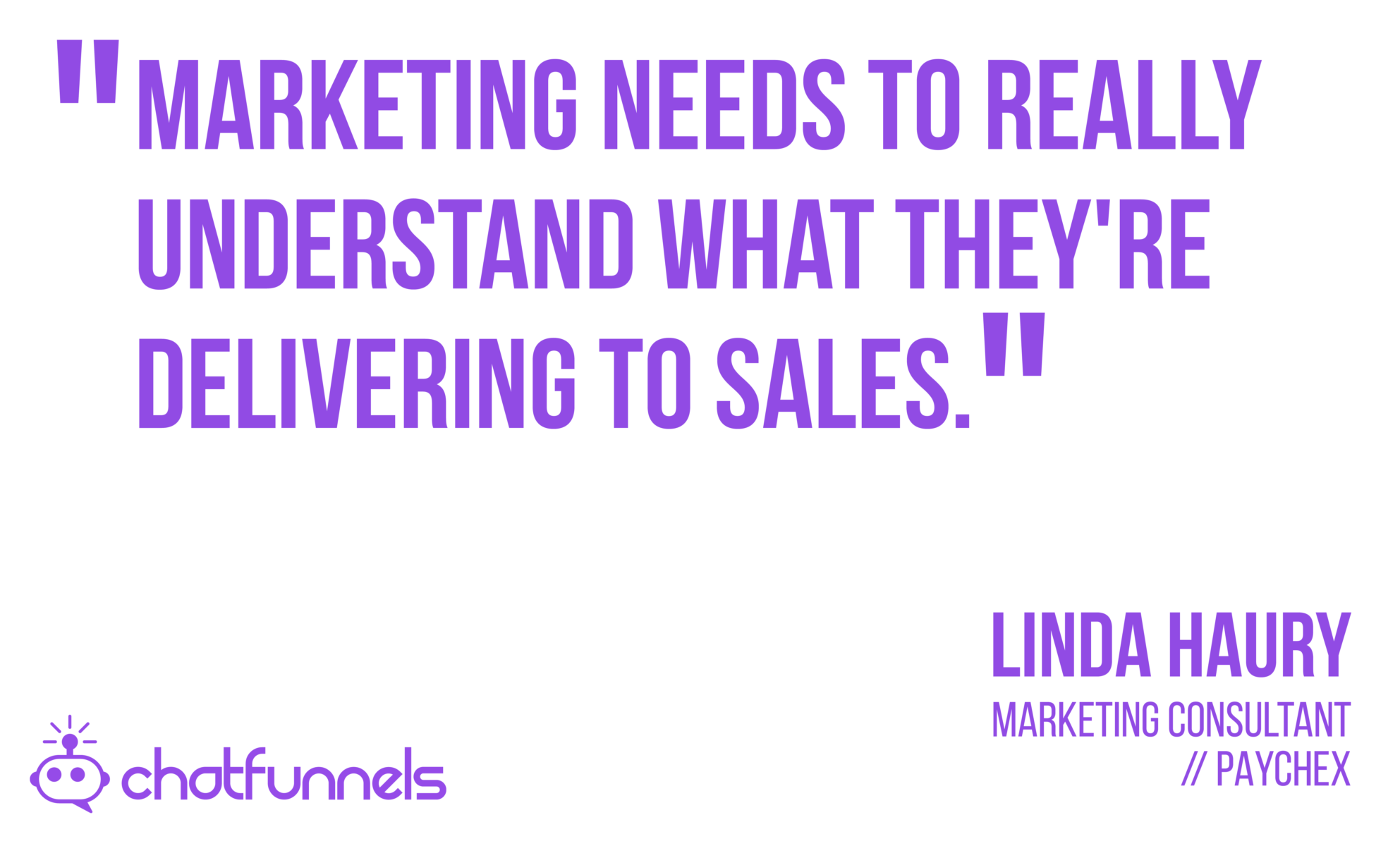
Linda: Yeah, so I’m a real believer in sales and marketing alignment. And that happened early on in my career. And I think something that was very beneficial, and a lot of companies don’t do it, is we have marketing from a field perspective reporting into sales. Everything marketing did was really focus on how we were helping sales. So now you have to determine the difference between sales promotion and marketing.
So, marketing needs to really understand what they’re delivering to sales. And many companies and I’ll say 9 out of 10 companies, right, all those leads that marketing is getting, us they are really crummy leads and they’re not worth following up on. Well, my methodology has been to work with sales leadership right from the beginning, and the sales organization and say, Okay, guys, what is a qualified lead? What are the attributes you consider a lead to be qualified, and that you’re willing to follow up on. And going through sort of the demand funnel and all the taxonomy.
What is a marketing qualified lead, sales qualified lead? I think really getting alignment and agreement on what are those definitions? And then what are you going to deliver the sales. Once you have sort of an SLA service level agreement with sales that says, Okay, this is what we’re going to deliver, you have agreed this is what you want. Now you have to help me marketing and have to follow up on those leads.
So, velocity is really important. So leads can’t sit. Not only can they not sit, but once sales follows up on them, the disposition of that leads and has to be put into the CRM system. So there’s now a flow. So the link isn’t broken by someone not putting that information back into the system. If you can get that agreement upfront. You start to deliver leads to sales that makes sense for them.
And it’s not just a lot of marketing leads, and sometimes less is more. And they’re going to get less leads, because they’re asking them to be a lot more qualified by their definition. But the leads that you get, there’s now no longer an excuse for people not to follow up on the lead, because that’s exactly what they asked me to give them. And it’s a really hard conversation, for sales to come back at marketing with when you’ve done this together. So I think doing it together, showing them what it could be. If you follow up on the lead here’s how we can track them. Here’s how we can understand.
There’s things we really need to understand like, what is the behavioral pattern of these leads, and we’ve been kind of going into predictive modeling, which is where you really ultimately want to be at the end of the day.
Billy: Yeah, no, I want to get into that predictive modeling with you. But I’ve got a follow up question on how do we get the definition of what you’re going to deliver to sales? I mean, it sounds like the right thing. And again, you want to be like yep, we should sit down, we should agree and get on the same team. But the devil is really in the details of these kinds of things.
When you’re having that conversation with sales, I’d imagine it’s not always easy to have. Especially like a new leader coming in, and sales has already been there. Maybe they’ve been through a couple marketing leaders already. Do you have any advice for a marketing leader that’s like, let’s get on the same page. Let’s get this SLA in place when they approach sales to do that?
Who Is Driving Revenue?
Linda: Yeah, I think that, you know, one of the areas that there has to be agreement on, and this is where a lot of times sales and marketing fall apart, because they don’t agree. And what is marketing responsible for? Right, from a demand generation perspective? What are you really looking for from marketing? And I like to say, marketing is responsible for opportunity pipeline.
So what do I mean by that? Opportunity pipeline is really the science part of marketing right. Now we have the art and science, everything is data driven. Opportunity pipeline is delivering the right lead to sales so they have a higher propensity to close that sale. And I’ll say marketing is b2b doesn’t include e commerce right? Can only be credited with building pipelines. And sales are the ones that really drive revenue. So anybody who says marketing is driving revenue has it not quite right.
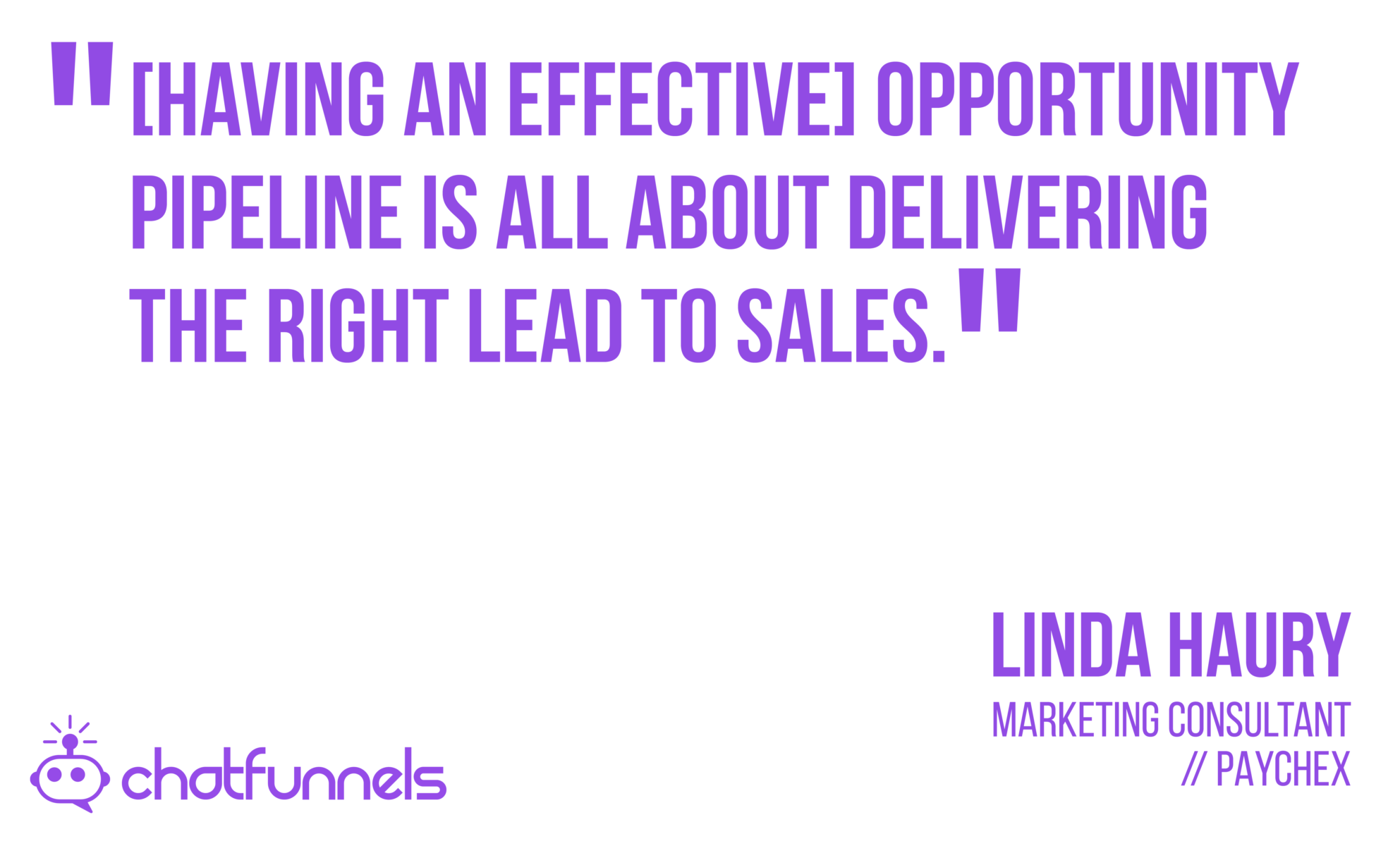
Like I said, many Marketing Leaders get this wrong. And they want to be credited for driving revenue because everybody wants to drive revenue. But marketing influences revenue, but sales closes the business. And I think when you have that distinction, sales understands that marketing knows who their swim lane is. And you don’t want to take credit for revenue because sales always want to take credit for revenue and they should, they’re the ones who actually do the closing.
Billy: No, I agree with you. If you had one metric to measure marketing off of, really should be the pipeline. And then sales is about getting in there to make that pipeline turn into actual revenue. Because it’s just a handoff at that point
Linda: And then it becomes a partnership, right? It turns into partnership at that point.
Billy: Yeah, it’s not just Hey, I we sent over, X amount of leads, email addresses to you now make it happen. Sso let’s dig into the predictive predictive modeling. How do you put yourself in a position to be to be able to even start doing that?
A Data-Driven Approach
Linda: Yeah, data is king, right? We’ve talked about data driven marketing. It couldn’t be more important than including predictive modeling. Predictive modeling is about leveraging historical data, to uncover real time insights and to predict future outcomes. I mean, that’s what really predictive modeling is. It’s really become the ultimate tool in the marketing toolkit today. It’s kind of utopia where everyone wants to get to. The problem is usually with the data.
There really are a few types of predictive modeling. But when you’re talking about at from a sales and a product perspective, right? There’s product modeling things of that sort. But really, segmentation modeling is the most common type of modeling when you’re looking at demand generation. Right? It’s behavioral clustering, and how leads convert and the path that they take to get there. Once that’s combined with the demographics or the firmographics, it identifies the commonalities in the trends that helped create those new targets. So, by creating future leads that match the same sequential behavior actions, that’s where I usually see conversion rates increasing.
But again, it really relies on the quality of the data. None of it’s possible without that clean quality data supported by good customer data. And it’s a foundation upon which active predicting insights really rect. So your data is key. And that’s where companies today are struggling a little bit for predictive modeling, because they don’t have that clean data.
Billy: I mean, with anything you do, if you’re gonna do the analytics, you got to have good data. So let me ask you this, then Linda, what tools do you recommend for collecting that data? Is my first question.
Linda: Yeah, I mean, that’s really that data is really a lot of times collected in your CRM system Because you really want your customer data. A lot of it is sort of the responsibility of the BI team, right? The Business Intelligence team. It’s really being sure that the data is and there are a lot of tools. Sixth Sense does it, Lead Sourcing does it. And you really need to be sure that the attributes of that data is accurate. People move from job to job very quickly.
So what I like to do is I like to like things like LinkedIn on top of the top of the data, because people are usually pretty current and where they are with their LinkedIn accounts. So there’s some tools that LinkedIn uses that you can actually compare your data with. And that’s really a good means for where people currently are because people move quickly. The other is the data with companies that are multi level company. So you have a parent child relationship, for the company, these big conglomerate.
I mean, you really need to use things the old DMV. DMV is still a good tool to use to really understand that parent child relationship. Because what you want to do, is you really want to look at ABM marketing now, more than demand generation. You want to be able to get into the account and understand who really the buyers are? Many times, its more than one buyer.
Billy: Oh, for sure. I think in b2b a lot of times if you’re selling more than just, you know, something that’s like 100 bucks a month, you got to get more than more than one person to sign off on it. So what are your thoughts on just getting into ABM marketing? Because it seems like it’s gonna be more and more something we’re all gonna have to deal with in b2b. Where do you see that going? And how do you see sales and marketing working together on something like that?
ABM Marketing; The Future of Demand Generation
Linda: Yeah, I think, you know, really understand your target and what you’re trying to accomplish, right? Is it lead generation, like you said, for those small transactional, maybe even reoccurring business. Or is it really about enterprise marketing? Or the mid to mid to large sized companies, right. What are you trying to accomplish? Once you can figure that out, because they’re very different, right? You’re going to think more about ABM marketing and account-based marketing is really where the world is moving today and quickly.
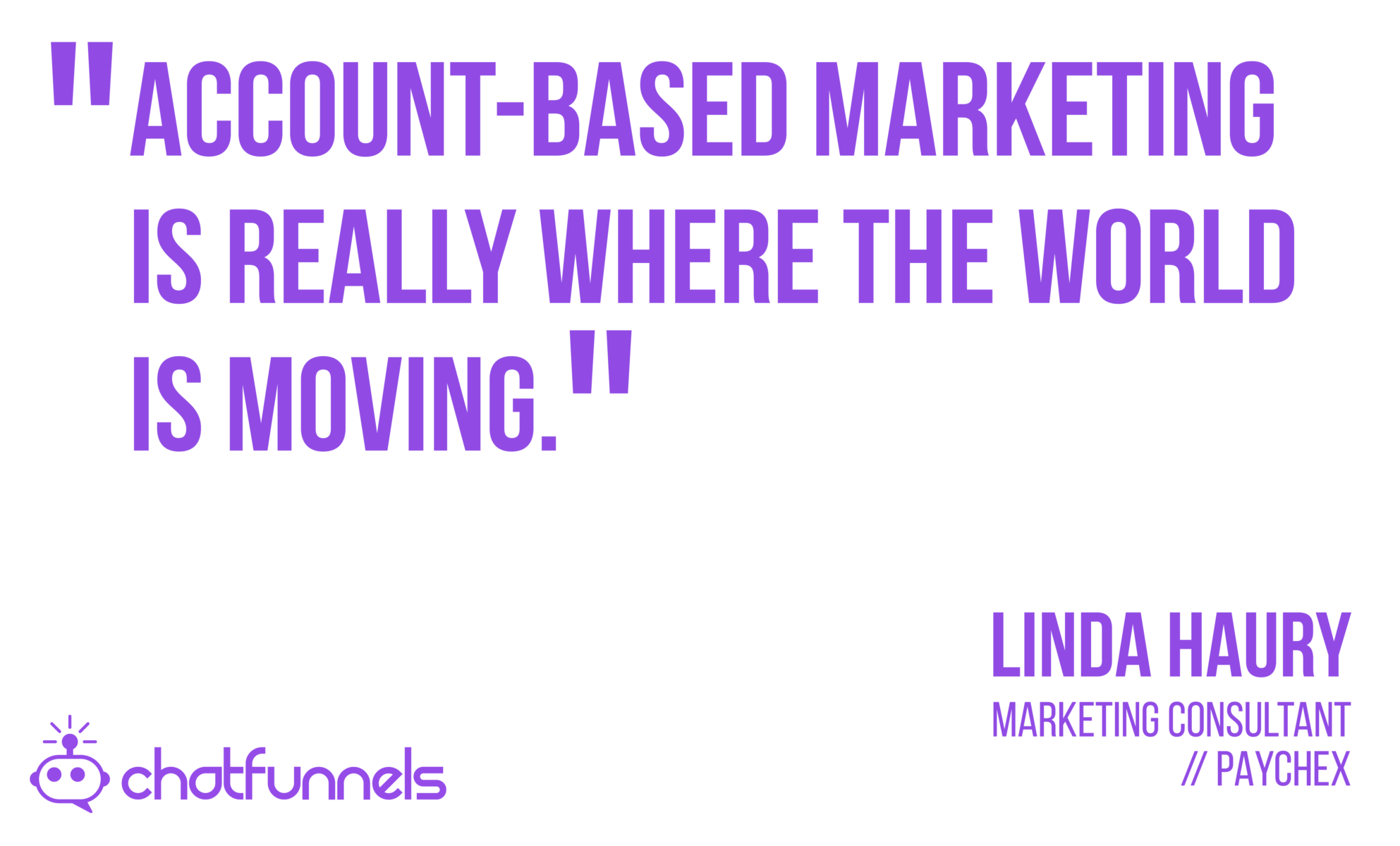
I needed to look at, you know what positions are opened it. I mean everybody wants ABM experts because there aren’t many out there. And you know, ABM answers the bigger question of what’s marketing’s impact on influencing those opportunities, right? You have to answer questions like or marketing will be asked questions like, how many accounts have you reached? How’s the engagement improved over time? Maybe how your program’s influencing opportunity creation? Notice a theme there.
None of the questions center around how many leads are generated. It’s more about how deeply have you penetrated that customer.? How much do you know about that account? What’s your propensity of them to buy? And more and more companies are realizing that that lead driven world does not leave the impact companies are looking for to increase revenue. And I think that’s why the big change has really come about with ABM marketing. It is not a single decision unless it’s a really, you know, low ASP average selling price of a product. But once you start really getting into having to spend some money and those are the companies that are doing the ABM marketing, right, they have bigger products and services to sell.
You really need to, to have a buyer committee and how do you reach that committee? How do you do it personalized, you must personalize. The other thing people don’t realize you need to personalize even within one company, you may have four buyers. You need to personalize each of those messages to those four different buyers because they have different pain points.
Billy: Yeah, I agree with you. It is more like what accounts are we working? And how are we touching those people and making contact? I know Xant is doing some really interesting things around the buyer committee with their new product. And, you know, hey, you’re talking to Jim here at ADP. Well, if you’re talking to Jim, you should probably be talking to Jenny and Sherry as well.
And then even if our own customers as we’ve talked to them and what features they want, ABM is coming up in almost every conversation right now. So it’s something we’ve all got to be thinking about, and we’ve started building out our own ABM functionality as well. So okay, I’ve got a couple more questions for you. One would be if somebody is starting out in a demand gen role, it’s maybe they’re fresh out of college, their first job in marketing or they’ve decided to transition into this. What’s your best piece of advice for them?
Linda: Oh, I think my number one piece of advice is for any company they’re looking to join, understand sales and marketings relationship. Because not all companies are created equal in that equation. And if you’re going to really try to do demand generation, as we started our talk earlier on, sales and marketing has to be aligned. And I think you really have to have a good understanding of who the target market is. So I would say, if you get the job and you’re in there, and sales and marketing is aligned, the next question you really need to drill down on is who we trying to reach? And why are we trying to reach them. And then, you know, building up personas. Understand how to build personas. That’s very, very important in all aspects of marketing, but more specifically, in the whole demand generation.
So I would say number one is understanding relationships between sales and marketing because it has to work. And also understand, and this goes almost back, you know, to my mentoring that I talked about early on, and I’m a big believer in. Success in businesses is about teams. No one person is successful on their own and demand generation takes a team. It’s not an individual contributor, kind of maybe an individual contributor position.
But it really is a position that needs to work cross functionally with product, cross functional with sales. I mean, functionally with field marketing if you’re in a decentralized model, so sales and marketing alignment is going to be key.
Billy: Awesome. Okay, before I let you go, is there anything that that I should have asked you that I didn’t? You’re thinking if Billy was really smart, he would have asked me this question.
Know Your Metrics
Linda: Let me see. I think yeah, I think you covered the gamut. I mean, I think it’s important to know, metrics right, you know, what do you want to measure, since everything is so data driven? Be sure you have metrics, metrics is a double edged sword. You can have too many metrics and most people err on the side of too many. And early on in my career, I had a president of the company who was very operationally driven. And he looked at me and I was doing demand generation that I want five metrics. That’s all I want. I want five metrics to measure the health of marketing, and everything else you marketing folks can go to town on, but stop showing me 20 metrics.

So I think that’s another good piece of advice is to understand what you want to measure and sum it up to what the executives want to see, versus where marketing gets into the weeds and really need to understand the data to do optimization, A/B testing, things of that sort. But executives aren’t as interested in all of the lower level metrics. And you have to the key is to try to bubble up what’s really important into your top five metrics, and use those to really understand the health of marketing.
Billy: I’m gonna ask one more question now. What were those five metrics? If you remember?
Linda: Oh, I knew you’re gonna ask that. Let me let me go back into my memory bank, of course, you know, opportunity pipeline is always one. Cost per lead, because you want to manage the cost of your programs. So they always want to know what their ROI was right. And we met we were able to measure ROI because our CRM systems connected with our financial systems, but cost per lead, opportunity pipeline. Oh, channel metrics, which channels are working best, especially with digital now? You know, PPC, is it display and then some of the ancillary things like, you know, what is the performance of the marketing organization? Right, what is the return on investment per person.
That’s another thing that’s also an interesting metric and people don’t think about that. That was metric number five. You get that because are you staffed to meet the need of what you’re trying to market? Because most times you’re not. Marketing’s always the first place to cut budget, if you can prove your people’s worth.
Billy: We track that here at ChatFunnels on the marketing team. Because, yeah, it always is the first one, or like, let’s get rid of marketing. We don’t need all these people. But if you can prove that, then at least you’re going to make leadership think twice. Before right. So awesome. Awesome. Thank you, Linda. And if someone wants to continue the conversation with you, what’s the best way for them to contact you?
Linda: Oh, probably, I make an effort to check LinkedIn messaging at least once a day. I get a lot of people who communicate with me through that. I think that’s the easiest way to really contact me and know that I’m open to you know, discussing with anyone any of you know, their concerns or their issues with marketing demand generation building high performing teams. You know, I welcome the opportunity to help wherever I can.
Billy: All right, thank you again, Linda, and we’ll chat later
Linda: Okay, thank you Billy, enjoyed it.
